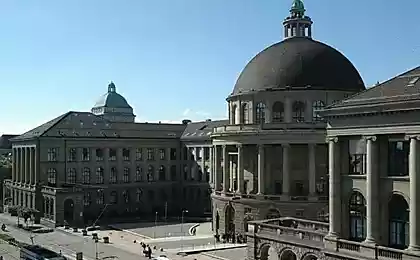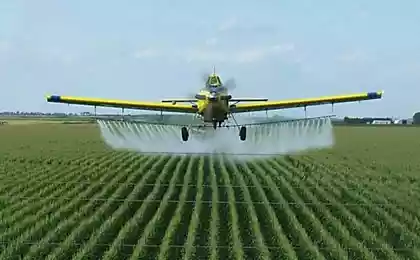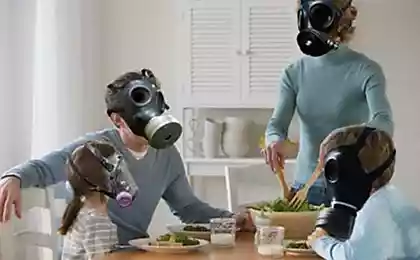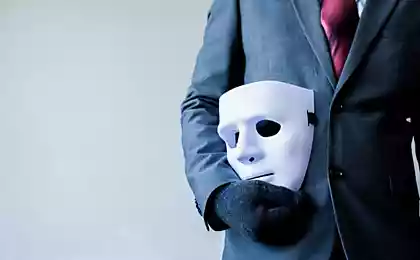572
The most toxic pesticides: the Top 12

Pesticides and insecticides, which are widely used in industrial agriculture can not only destroy pests, but can also be dangerous to animals and humans, at the same time they have a long period of decomposition. We present you the "dirty dozen", the most dangerous and toxic pesticides, which should be avoided.
The main problem of pesticides is that for a person they do not have the immediate effect of the action. Pesticides accumulate in fat tissue and remain in the environment long after their use and at some point it affects our health. Often they are called Persistent Organic Pollutants (POPS).
Many of these pesticides are officially interpreted as "possibly carcinogenic to humans". For ethical reasons, no one dared to say directly that the studies of people diagnosed with cancer. And in most cases, such human studies have been carried out. Risk assessment remains the sole discretion of each.
"The dirty dozen" is officially banned under the Stockholm Convention of the United Nations since 2001, when 90 countries such as USA and the EU took the decision to reduce or cease production of POPS. In 2011, this Convention has been signed and Russia.
The 12 most toxic pesticides
1. Aldrin. The insecticide used for seed treatment and soil.Toxic to fish; possibly carcinogenic to humans.
2. Chlordane. Insecticide used to protect lawns and destruction of termites. It is perhaps the cause of a number of cancers.
3. DDT. Was the first of many pesticides, with which people hoped to improve their quality of life. Scientists are still trying to understand how it causes a broad and unexpected effects on the environment and human health.
Wide use of DDT has led to the fact that it is found in the fatty tissues of nearly all large animals and humans. The use of DDT led to a strong decline in the population of birds of prey, reduces the reproduction of fishes and snakes.
In 60-ies was the book "Silent spring," in which Rachel Carson described a simple food chain involving DDT. To destroy the fungus, the pathogen of Dutch elm disease and parkland were treated with DDT. The remnants settled on the trees of DDT were then rainwater or fallen leaves in the soil or leaf litter. There DDT was absorbed by earthworms. Then DDT was ingested by migratory thrushes, which eat mainly earthworms. This does not always lead to death of birds, but it was often enough 10 worms to the Blackbird died. Also, this gives them an impaired ability to reproduce. They become sterile or lay infertile eggs, or their Chicks die, especially if the parents feed them earthworms. Therefore, the fight against Dutch elm disease with DDT resulted in an almost complete disappearance of migratory thrushes in large parts of the United States.
This story has caused a serious resonance in the society. And manufacturers of pesticides has allocated 250 000$ to disprove the theory about the dangers of DDT. But time will put everything in its place.
4. Dieldrin. An insecticide developed as alterantive DDT. Similar to DDT, it moves through food chains and accumulate in the tissues of living organisms, which can lead to tragic results. Dose causing death of 50% of the rats and other small animals, 25-30 mg/kg.
5. Endrin. The insecticide also used to kill rats. The main source of endrin penetration in the human body — food. It damages the reproductive system, bioaccumulates in fish and shellfish.
6. Heptachlor. Insecticide. Studies have shown that heptachlor is 7% increases the risk of developing diabetes. Classified by the International Agency for study on cancer IARC as possibly carcinogenic
7. Hexachlorobenzene. Insecticide, fungicide, is stable pollutant. A proven carcinogenic effect in animals; possible human carcinogen. Very toxic for living in water organisms. Banned in the USA in 1996, but still contained in the environment.
In Russia known for its use in mixture with other drugs as a seed treatment for control of diseases of wheat, rye, buckwheat, soybeans and other crops. Until 1991. for the needs of agriculture were released annually up to 120-150 tons of GHB, which was part of such fungicides as gamma-hexane, hexadienal, mercurbenzol, Fagus, etc. are currently also used by the defense industry in the manufacture of fireworks.
8. Mirex. An insecticide used to kill fire ants. According to research causes cancer in rats and mice; highly toxic to water living organisms. Classified as a possible human carcinogen.
We have not applied.
9. Toxigen. The insecticide used in the cotton industry. Used to control the Colorado potato beetle and pests of sugar beet and peas. Affects the lungs and nervous system, is classified as a possible carcinogen.
10. Polychlorinated biphenyl. Was used as a cooling fluid for transformers. It is proved carcinogenic in animals; possible human carcinogen.
11. Polychlordibenzodioxins and polychlordibenzofurans. Dioxins are formed mainly by thermal processing of chlorine containing waste. Exposure to dioxins leads to a number of serious health problems, ranging from malignancy and ending with the decline of sperm quality and adverse effects on the immune system. A full list of these problems is too wide and not all adverse effects of dioxin arise from their application as pesticides. During the war in Vietnam, the US sprayed 76 million litres of dioxin in the agricultural field to weaken the enemy positions. As a result, today there is a high content of these substances.
12. Polychlorinated biphenyls PCBs. Hazardous pollutants have been used as cooling fluid for transformers.published
P. S. And remember, only by changing their consumption — together we change the world! ©
Source: energiya-yar.ru/alternativnaja-energetika/424-ast.html























